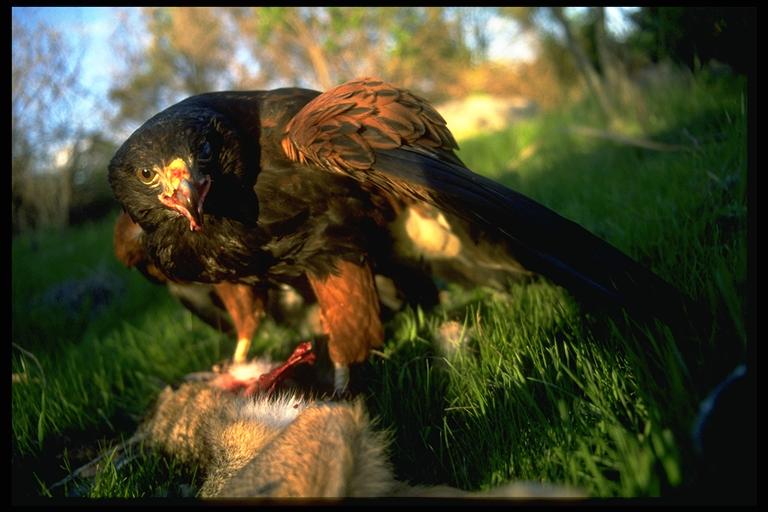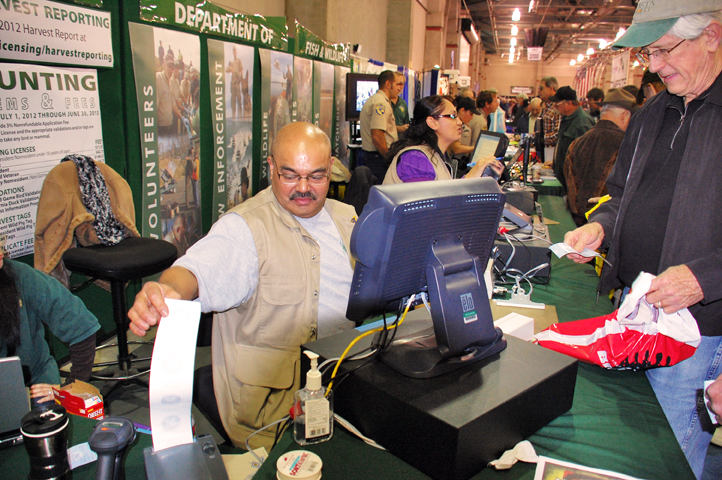Fish Report for 1-18-2019
What Can I Do About a Hawk Eating Its Lunch in My Yard?

by CDFW
1-18-2019
Website
Question: How can we discourage hawks from eating their prey in our backyard? Two days ago we watched a hawk eat a dove, making a huge mess everywhere. It came back today with a different bird, leaving a bloody mess and two feet behind. Is there a way to properly haze them or otherwise shoo them away? (Tierney)
Answer: It sounds like the raptor is just doing what raptors naturally do. If it’s not causing harm or damage to your property (other than just making a mess), one could argue that this is a rare opportunity to watch nature at work, up close, in your own backyard – in this case, predator/prey dynamics.
If you really find the front-row view bothersome, you may be able to discourage the raptor from coming into your yard to eat its prey by putting up a plastic owl figure or placing reflective ribbons along your fence line, similar to deterrent techniques used in agricultural operations. If you’re currently using a bird feeder, take it down, as bird feeders will attract the smaller birds that are a common source of prey for some hawks.
Understand it’s a trade-off: if you do these things, you’ll also discourage other birds from coming into your yard.
What is Legal to Collect for a Home Aquarium?
Question: I’ve been doing some research to see if it is ok to collect marine animals and/or plants for a private tank aquarium, but have not been able to find much information. Is it ok to put any type of “fin fish” in an aquarium? Is it ok to put invertebrates (clams, rock scallops, sea urchin, octopus, shrimp, etc.) in an aquarium? What about legal-size California spiny lobster, or marine plants? (Garrett)
Answer: The only finfish you may possess and display in your home aquarium are those purchased legally through a commercial aquarium vendor and/or pet supply business. Live finfish may not be collected from the wild for aquarium display because it is illegal to transport live “finfish” from the wild (California Code of Regulations Title 14, section 1.63).
Live marine invertebrates may be collected, but only under the authority of a sport fishing license, and only those species allowed under a sport fishing license may be taken. In addition, any species with sport fishing restrictions (e.g. bag, size, possession, season limits, methods of take) are still covered under those regulations, and so collectors must also abide by these laws.
Invertebrates collected under the authority of a sport fishing license may not be used to establish breeding colonies for sale or trade with other people. Any trading, selling or possession for sale or trade of these animals constitutes commercial marine aquaria pet trade activity and requires all parties to hold “marine aquaria collectors permits” authorizing this practice. A marine collector’s permit is also required for any animals on display for the public.
Marine plants or algae, with the exception of eel grass (Zostera), surf grass (Phyllospadix) or sea palm (Postelsia), may be harvested from the wild as long as they are not taken from state marine reserves. State marine conservation areas and state marine parks may prohibit take. The daily bag limit on all marine aquatic plants for which the take is authorized is 10 pounds wet weight in the aggregate.
Can I Archery Shoot Near a Residence?
Question: I am curious about the regulation restricting shooting within 150 yards of an occupied dwelling. Does that apply to archery-type shooting, where one would be shooting directly away from the dwelling? (George)
Answer: California Fish and Game Code, section 3004 (a) states: It is unlawful for a person, other than the owner, person in possession of the premises, or a person having the express permission of the owner or person in possession of the premises, while within 150 yards of an occupied dwelling house, residence, or other building, or within 150 yards of a barn or other outbuilding used in connection with an occupied dwelling house, residence, or other building, to either hunt or discharge a firearm or other deadly weapon while hunting.
The 150-yard area is a “safety zone.” This means that no firearm or other deadly weapon such as a hunting bow can be discharged while hunting within 150 yards of the stated buildings without “express permission” (assuming you are not the owner or tenant of the property), and no hunting can occur inside that 150 yard zone without meeting the above requirements.
Shooting a firearm or bow for target practice would not be prohibited under section 3004 – but there could be city or county restrictions that apply, so it is incumbent upon you to check local ordinances. Section 3004 (b) also states that it is unlawful for a person to intentionally discharge a firearm or release an arrow or crossbow bolt over or across a public road or other established way open to the public in an unsafe and reckless manner. This applies to any type of shooting with a firearm or bow that is shot over a road.
More Reports
CDFW to sell Hunting and Fishing Licenses, answer questions at ISE Show

1-17-2019
The California Department of Fish and Wildlife (CDFW) is returning to the International Sportsmen’s Exposition (ISE) at Cal Expo in...... Read More
Northern Commercial Dungeness Crab Season Further Delayed in Ocean Waters North of Patrick’s Point, Humboldt County

1-8-2019
California Department of Fish and Wildlife (CDFW) Director Charlton H. Bonham delayed the opening of the commercial Dungeness crab fishery from Patrick’s...... Read More

Website Hosting and Design provided by TECK.net